
Genus is a taxonomic rank above species and below family as used in the biological classification of living and fossil organisms as well as viruses. In binomial nomenclature, the genus name forms the first part of the binomial species name for each species within the genus.
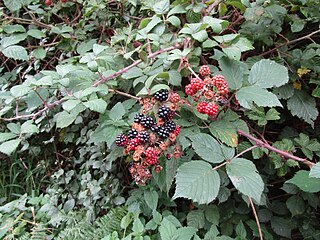
Rubus is a large and diverse genus of flowering plants in the rose family, Rosaceae, subfamily Rosoideae, with over 1,350 species, commonly known as brambles.

Senecio is a genus of flowering plants in the daisy family (Asteraceae) that includes ragworts and groundsels.
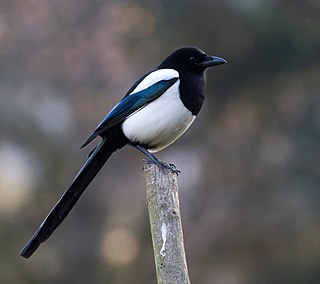
Magpies are birds of various species of the family Corvidae. Like other members of their family, they are widely considered to be intelligent creatures. The Eurasian magpie, for instance, is thought to rank among the world's most intelligent creatures, and is one of the few nonmammalian species able to recognize itself in a mirror test. Magpies have shown the ability to make and use tools, imitate human speech, grieve, play games, and work in teams. They are particularly well known for their songs and were once popular as cagebirds. In addition to other members of the genus Pica, corvids considered magpies are in the genera Cissa, Urocissa, and Cyanopica.
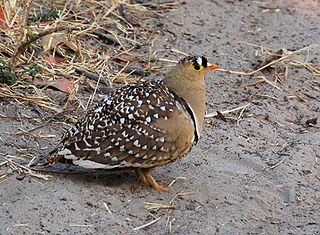
Sandgrouse is the common name for Pteroclidae, a family of sixteen species of bird, members of the order Pterocliformes. They are traditionally placed in two genera. The two central Asian species are classified as Syrrhaptes and the other fourteen species, from Africa and Asia, are placed in the genus Pterocles. They are ground-dwelling birds restricted to treeless, open country, such as plains, savannahs, and semi-deserts. They are distributed across northern, southern, and eastern Africa, Madagascar, the Middle East, and India through central Asia. The ranges of the black-bellied sandgrouse and the pin-tailed sandgrouse even extend into the Iberian Peninsula and France, and Pallas's sandgrouse occasionally breaks out in large numbers from its normal range in Asia.

Camelids are members of the biological family Camelidae, the only currently living family in the suborder Tylopoda. The seven extant members of this group are: dromedary camels, Bactrian camels, wild Bactrian camels, llamas, alpacas, vicuñas, and guanacos. Camelids are even-toed ungulates classified in the order Artiodactyla, along with species including whales, pigs, deer, cattle, and antelopes.
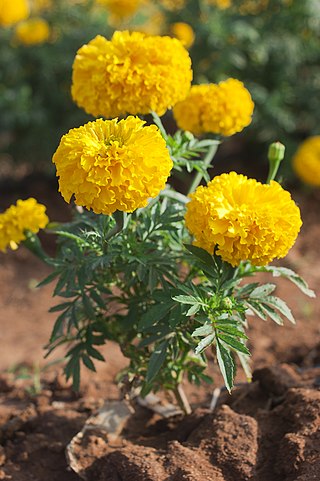
Tagetes is a genus of 50 species of annual or perennial, mostly herbaceous plants in the family Asteraceae. They are among several groups of plants known in English as marigolds. The genus Tagetes was described by Carl Linnaeus in 1753.

Iridaceae is a family of plants in order Asparagales, taking its name from the irises. It has a nearly global distribution, with 69 accepted genera with a total of c. 2500 species. It includes a number of economically important cultivated plants, such as species of Freesia, Gladiolus, and Crocus, as well as the crop saffron.
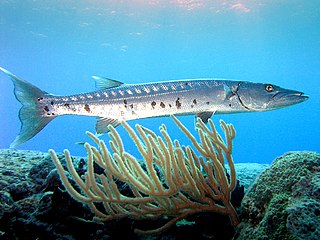
A barracuda is a large, predatory, ray-finned fish known for its fearsome appearance and ferocious behaviour. The barracuda is a saltwater fish of the genus Sphyraena, the only genus in the family Sphyraenidae, which was named by Constantine Samuel Rafinesque in 1815. It is found in tropical and subtropical oceans worldwide ranging from the eastern border of the Atlantic Ocean to the Red Sea, on its western border the Caribbean Sea, and in tropical areas of the Pacific Ocean. Barracudas reside near the top of the water and near coral reefs and sea grasses. Barracudas are targeted by sport-fishing enthusiasts.

Carpet sharks are sharks classified in the order Orectolobiformes. Sometimes the common name "carpet shark" is used interchangeably with "wobbegong", which is the common name of sharks in the family Orectolobidae. Carpet sharks have five gill slits, two spineless dorsal fins, and a small mouth that does not extend past the eyes. Many species have barbels.

Lycopodium is a genus of clubmosses, also known as ground pines or creeping cedars, in the family Lycopodiaceae. Two very different circumscriptions of the genus are in use. In the Pteridophyte Phylogeny Group classification of 2016, Lycopodium is one of nine genera in the subfamily Lycopodioideae, and has from nine to 15 species. In other classifications, the genus is equivalent to the whole of the subfamily, since it includes all of the other genera. More than 40 species are accepted.

Nectria is a genus of Ascomycete fungi. They are most often encountered as saprophytes on decaying wood but some species can also occur as parasites of trees, especially fruit trees and a number of other hardwood trees. Some species are significant pests causing diseases such as apple canker, Nectria twig blight, and coral spot in orchards.

The Batrachedridae are a small family of tiny moths. These are small, slender moths which rest with their wings wrapped tightly around their bodies.

The genus Cathartes includes medium-sized to large carrion-feeding birds in the New World vulture (Cathartidae) family. The three extant species currently classified in this genus occur widely in the Americas. There is one extinct species known from the Quaternary of Cuba.

Sphaerobolus is a genus of fungi in the family Geastraceae. Commonly known as the "shotgun fungus", "artillery fungus" or "cannonball fungus", species discharge their spores with explosive force. Discharged spore sacs are sticky and have a tendency to strongly adhere to whatever surface they encounter, making them a nuisance to homeowners, pressure washing contractors, landscape mulch producers and insurance companies.

Prohalecites is an extinct genus of ray-finned fish from the Ladinian and possibly Carnian (Triassic) of Italy. It is the oldest known teleosteomorph, a group that includes extant teleosts and their close fossil relatives.
Endoxyla is a genus of fungi within the Boliniaceae family.

Smiliinae is a subfamily of treehoppers in the family Membracidae. These are bugs and include about 100 genera in 10 tribes.
Stilbum is a genus of fungi in the family Chionosphaeraceae. Though many species were formerly referred to the genus, it is effectively monotypic since the type species, Stilbum vulgare, currently has no close relative. Stilbum vulgare forms groups of minute, gelatinous, synnema-like basidiocarps up to 0.5 mm tall with a distinct stem and inflated, fertile head. Microscopically, it produces auricularioid basidia and basidiospores that germinate by budding off yeast cells. The species has been collected on rotting wood and old agaric fruit bodies and may be a parasite of other fungi. It was originally described from Europe, but is also known from Asia, North America, and Australia.
















